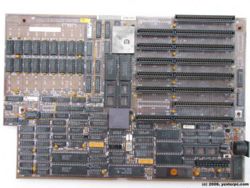Difference between revisions of "IBM AT"
m (+cat) |
m (rm dup link) |
||
| (4 intermediate revisions by the same user not shown) | |||
| Line 8: | Line 8: | ||
}} | }} | ||
| − | The | + | The '''IBM AT''', also known as the '''IBM 5170''' was the machine that introduced 16-[[bit]] [[Industry Standard Architecture|ISA]] slots, and the 'advanced' [[i286]] [[Central Processing Unit|CPU]]. |
| + | |||
| + | The 16-bit ISA slots added an additional plug on the board for the extra address pins & IRQ pins, while keeping the existing 8 bit ISA slot in place. Thus the AT could use 8bit cards without modification. The AT also ran its ISA bus at 6MHz, vs the PC/XT's 4.77MHz making the AT all around faster. | ||
| + | |||
| + | Until the rise of the [[Pentium II]] CPU, the IBM AT [[motherboard]] was the standard size for clone motherboards with 286 and greater CPUs. | ||
| − | |||
[[Image:IBM 5170 motherboard.jpg|thumb|right|250px|IBM AT Motherboard]] | [[Image:IBM 5170 motherboard.jpg|thumb|right|250px|IBM AT Motherboard]] | ||
| − | The IBM AT unlike the [[IBM XT]] is fully 16 bit, with a | + | The IBM AT unlike the [[IBM XT]] is fully 16 bit, with a 16-bit [[data bus]], 24-bit [[address bus]], and 16-bit ISA expansion bus. IBM had also promised along with the AT that it would support the next generation of [[operating system]]s, [[OS/2]]. The AT was also able to run [[Xenix]], along with a special [[protected mode]] version of Xenix. |
| − | All BIOS's with computers with a 286 or greater CPU are compatible with the IBM AT. | + | All [[BIOS]]'s with computers with a 286 or greater CPU are compatible with the IBM AT. |
| − | The IBM AT shipped with a WD-1002 controller, that supported MFM hard | + | The IBM AT shipped with a WD-1002 [[controller]], that supported MFM hard [[disk]]s, but unlike other controllers, the control code was in the IBM AT, and the drive parameter table was burned into the BIOS, and the selection was saved into the non volatile RAM. The AT also required a special diskette to set up the [[NVRAM]], while clones typically didn't include the ROM BASIC, and instead included a setup & diagnostic program in ROM. |
| − | Also in this model, was the introduction of high density | + | Also in this model, was the introduction of high density [[diskette]]s, starting with the 5 1/4" 1.2MB drive. Many AT specific things shipped on high density disks to prevent PC/XT users from using these programs. OS/2 was one such program, along with Microsoft C 5.1 where the OS/2 components were on high density disks, while the rest of the [[compiler]] was on low density disks. I don't remember exactly how you got a 3 1/2" disk on an original AT, if it required a [[ROM]] update, or a 3rd party controller, or both. |
| − | The IBM AT was later supplanted by the [[PS/2]] line of computers. | + | The IBM AT was later supplanted by the [[IBM PS/2]] line of computers. |
| − | {{stub}} | + | {{semi-stub}} |
[[Category:IBM PCs]] | [[Category:IBM PCs]] | ||
Latest revision as of 22:41, 19 October 2018
| IBM 5170/IBM AT | |
 An IBM AT | |
| Manufacturer: | IBM |
|---|---|
| Year Introduced: | 1984 |
| Word Size: | 16 bit |
The IBM AT, also known as the IBM 5170 was the machine that introduced 16-bit ISA slots, and the 'advanced' i286 CPU.
The 16-bit ISA slots added an additional plug on the board for the extra address pins & IRQ pins, while keeping the existing 8 bit ISA slot in place. Thus the AT could use 8bit cards without modification. The AT also ran its ISA bus at 6MHz, vs the PC/XT's 4.77MHz making the AT all around faster.
Until the rise of the Pentium II CPU, the IBM AT motherboard was the standard size for clone motherboards with 286 and greater CPUs.
The IBM AT unlike the IBM XT is fully 16 bit, with a 16-bit data bus, 24-bit address bus, and 16-bit ISA expansion bus. IBM had also promised along with the AT that it would support the next generation of operating systems, OS/2. The AT was also able to run Xenix, along with a special protected mode version of Xenix.
All BIOS's with computers with a 286 or greater CPU are compatible with the IBM AT.
The IBM AT shipped with a WD-1002 controller, that supported MFM hard disks, but unlike other controllers, the control code was in the IBM AT, and the drive parameter table was burned into the BIOS, and the selection was saved into the non volatile RAM. The AT also required a special diskette to set up the NVRAM, while clones typically didn't include the ROM BASIC, and instead included a setup & diagnostic program in ROM.
Also in this model, was the introduction of high density diskettes, starting with the 5 1/4" 1.2MB drive. Many AT specific things shipped on high density disks to prevent PC/XT users from using these programs. OS/2 was one such program, along with Microsoft C 5.1 where the OS/2 components were on high density disks, while the rest of the compiler was on low density disks. I don't remember exactly how you got a 3 1/2" disk on an original AT, if it required a ROM update, or a 3rd party controller, or both.
The IBM AT was later supplanted by the IBM PS/2 line of computers.
